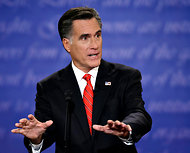Some readers of The New York Times – the version printed on trees – have noted that a headline on the front page of Friday’s paper emphasizes a different aspect of our analysis of tax trends than the accompanying chart. The headline says, “Complaints Aside, Most Face Lower Tax Burden Than in the Reagan ‘80s,” while the chart compares tax rates in 1980 and 2010. And as Greg Mankiw notes, President Ronald Reagan took office in 1981.
Both headline and chart are accurate, but there is an interesting difference.
We focused on a comparison with 1980 to capture the full extent of the changes since Reagan opened an era of cuts in federal taxation. As the article says:
Most Americans in 2010 paid far less in total taxes — federal, state and local — than they would have paid 30 years ago. According to an analysis by The New York Times, the combination of all income taxes, sales taxes and property taxes took a smaller share of their income than it took from households with the same inflation-adjusted income in 1980.
It is also true – and important — that reductions in federal taxation continued after Reagan left office. Indeed, those cuts have been large enough to outpace increases in state and local taxation. As the article also says, “Tax rates at most income levels were lower in 2010 than at any point during the 1980s.”
The difference between the two time frames is that while upper-income households have seen the largest percentage decline in the overall period since 1980, the rest of the population has seen the largest percentage declines in the years since Reagan’s presidency.
You can see these trends by income group, and year by year, in our interactive graphic.
For households making less than $25,000, taxes increased during the 1980s, then declined starting in the mid-1990s as both parties backed the expansion of government payments like the earned income tax credit.
Middle-income households did get a tax cut in 1981, but its value was steadily eroded by rising state and local taxes. Their taxes also began a fresh decline in the mid-1990s that continued unabated through 2010.
Upper-income households got the largest cuts in the 1980s, the largest increases in the 1990s, and the largest cuts in the 2000s.
There’s an important caveat to the front-page headline: For many upper-income households, average tax rates in 2010 were higher than at the ‘80s nadir — particularly the top income bracket, which includes 1 percent of households.
But average tax rates increased sharply for upper-income households in recent years not because of changes in tax policy but because a smaller share of earnings for those households came from investments, which are taxed at lower rates.
In 2007, before the recession, most upper-income households also paid a smaller share of income in taxes than comparable households during the “Reagan ’80s.”
Article source: http://economix.blogs.nytimes.com/2012/11/30/a-note-on-the-reagan-80s/?partner=rss&emc=rss


